Durability and Strength Characteristics of Casein-Cemented Sand with Slag
Abstract
1. Introduction
2. Materials and Testing Methods
2.1. Materials
2.1.1. Jumunjin Sand and Blast Furnace Slag
2.1.2. Casein Binders
2.1.3. Sample Preparation
2.2. Testing Methods
2.2.1. Lead Zirconate Titanate (PZT) Sensor
2.2.2. Scanning Electron Microscope (SEM) Analysis
2.2.3. Unconfined Compression Test
2.2.4. Jar Slake Test
3. Results and Discussions
3.1. Results of Lead Zirconate Titanate (PZT) Sensor Analysis
3.2. Results of Scanning Electron Microscope (SEM) Analysis
3.3. Results of Unconfined Compression Test
3.4. Results of Durability Test
3.4.1. Jar Slake Test
3.4.2. Repeated Soaking Test
4. Conclusions
- In the solidity performance test using a PZT sensor, there was a continuous decrease in the peak conductance in all samples as the curing time increased until the 6th day, after which it plateaued. Also, the water content was lower than 1% from the 5th day. The curing period of 7 days was enough to harden the casein-cemented sand.
- The UCS and elastic modulus increased proportionately with the binder content for all STD, MOD, and MBS samples. The hydrate reaction of the blast furnace slag added in the binder appeared, and the UCS of the MBS sample (9806 kPa) was the highest, 1.35, 1.55, and 22 times higher than those of STD, MOD, and 6% ordinary Portland cement (OPC), respectively. Also, the UCS improved most when the same amount of casein binder and blast furnace slag was used.
- MBS binder was the most effective in enhancing the hydrophobicity and durability of the cement. The samples with MBS resisted in water even for 24 h without any separation and surface cracks. On the other hand, the STD and MOD samples collapsed in water in 3 and 20 h respectively.
- Although MBS samples showed great durability compared with other samples, their UCS decreased approximately 4 times, and 6 times whenever it was immersed twice, and 3 times, respectively. The bond between casein, slag, and sand particles becomes weaker with repeated submersion in water.
- The sands cemented with the casein revealed higher UCS than those of OPC sand when they were cured for seven days. However, their UCS decreased as the time of contact with water increased, and it was lower than the UCS of OPC when it contacted with water over than 24 h. We suggest the use of casein binder where high strength is required for a short time.
Author Contributions
Funding
Conflicts of Interest
Acronyms
| SH | Sodium Hydroxide |
| CH | Calcium Hydroxide |
| BFS | Blast Furnace Slag |
| STD | Standard Casein Binder |
| MOD | Modified Casein Binder |
| MBS | Modified + Blast Furnace Slag Casein Binder |
| UCS | Unconfined Compressive Strength |
| PZT | Lead Zirconate Titanate |
| SEM | Scanning Electron Microscope |
| USCS | Unified Soil Classification System |
| Cu | Uniformity Coefficient |
| Cc | Coefficient of Gradation |
| XRF | X-Ray Fluorescence |
| SCR | Ratio of Blast Furnace Slag to Casein |
| P.C. | Peak Conductance |
| C.F. | Corresponding Frequency |
| OPC | Ordinary Portland Cement |
| εpeak | Axial Strains at the Maximum Stress |
| E50 | Elastic modulus |
| C1-C6 | Jar slake Test Category |
References
- Shooshpasha, I.; Shirvani, R.A. Effect of cement stabilization on geotechnical properties of sandy soils. Géoméch. Eng. 2015, 8, 17–31. [Google Scholar] [CrossRef]
- Makusa, G.P. Soil Stabilization Methods and Materials; Lulea University of Technology: Lulea, Sweden, 2012. [Google Scholar]
- Ramaji, A.E. A review on the soil stabilization using low-cost methods. J. Appl. Sci. Res. 2012, 8, 2193–2196. [Google Scholar]
- Chang, I.; Im, J.; Prasidhi, A.K.; Cho, G.-C. Effects of Xanthan gum biopolymer on soil strengthening. Constr. Build. Mater. 2015, 74, 65–72. [Google Scholar] [CrossRef]
- Ayeldeen, M.; Negm, A.; el Sawwaf, M.A. Evaluating the physical characteristics of biopolymer/soil mixtures. Arab. J. Geosci. 2016, 9, 371. [Google Scholar] [CrossRef]
- Choi, S.-G.; Park, S.-S.; Wu, S.; Chu, J. Methods for Calcium Carbonate Content Measurement of Biocemented Soils. J. Mater. Civ. Eng. 2017, 29, 06017015. [Google Scholar] [CrossRef]
- Anagnostopoulos, C.A. Strength properties of an epoxy resin and cement-stabilized silty clay soil. Appl. Clay Sci. 2015, 114, 517–529. [Google Scholar] [CrossRef]
- Park, S.-S.; Choi, S.-G.; Nam, I.-H. Effect of Plant-Induced Calcite Precipitation on the Strength of Sand. J. Mater. Civ. Eng. 2014, 26, 06014017. [Google Scholar] [CrossRef]
- Chang, I.; Im, J.; Chung, M.-K.; Cho, G.-C. Bovine casein as a new soil strengthening binder from diary wastes. Constr. Build. Mater. 2018, 160, 1–9. [Google Scholar] [CrossRef]
- Jenness, R. Comparative aspects of milk proteins. J. Dairy Res. 1979, 46, 197–210. [Google Scholar] [CrossRef]
- Vick, C.B. Adhesive bonding of wood materials. Wood Handbook: Wood as an Engineering Material; General Technical Report FPL for Forest Service; Forest Products Laboratory: Madison, WI, USA, 1999; pp. 9.1–9.24. [Google Scholar]
- Skeist, I. Handbook of Adhesives, 3rd ed.; Chapman & Hall: New York, NY, USA, 2012. [Google Scholar]
- Choi, S.-G.; Park, S.-S.; Wang, K. Early-Age Strength of Alkali-Activated Slag Mortar Based on Burned Oyster Shell and Other Chemical Activators. J. Mater. Civ. Eng. 2019, 31, 04019186. [Google Scholar] [CrossRef]
- Song, S.; Sohn, D.; Jennings, H.M.; Mason, T.O. Hydration of alkali-activated ground granulated blast furnace slag. J. Mater. Sci. 2000, 35, 249–257. [Google Scholar] [CrossRef]
- Bellmann, F.; Stark, J. Activation of blast furnace slag by a new method. Cem. Concr. Res. 2009, 39, 644–650. [Google Scholar] [CrossRef]
- García, J.I.E.; Fuentes, A.F.; Gorokhovsky, A.; Fraire-Luna, P.E.; Mendoza-Suarez, G. Hydration Products and Reactivity of Blast-Furnace Slag Activated by Various Alkalis. J. Am. Ceram. Soc. 2003, 86, 2148–2153. [Google Scholar] [CrossRef]
- Allahverdi, A.; Mahinroosta, M. Mechanical activation of chemically activated high phosphorous slag content cement. Powder Technol. 2013, 245, 182–188. [Google Scholar] [CrossRef]
- Monshi, A.; Asgarani, M.K. Producing Portland cement from iron and steel slags and limestone. Cem. Concr. Res. 1999, 29, 1373–1377. [Google Scholar] [CrossRef]
- Lee, C.J.; Lee, J.C.; Shin, S.W.; Kim, W.J. Setting Characteristic Assessment of Cementitious Materials using Piezoelectric Sensor. J. Korea Inst. Build. Constr. 2016, 16, 389–395. [Google Scholar] [CrossRef]
- Park, S.S.; Woo, S.W.; Lee, J.S.; Lee, S.B.; Lee, J.C. Evaluation of Unit Weight and Strength of Sand Using Electro-Mechanical Impedance. J. Korean Geotech. Soc. 2018, 34, 33–42. [Google Scholar] [CrossRef]
- Forest products laboratory. Casein Glues Their Manufacture, Preparation, and Application; University of Wisconsin: Madison, WI, USA, 1967. [Google Scholar]
- Pizzi, A.; Mittal, K. Handbook of Adhesive Technology, Revised and Expanded; Informa UK Limited: London, UK, 2003. [Google Scholar]
- ASTM D2166. In Standard Test Method for Unconfined Compressive Strength of Cohesive Soil; Annual Book of ASTM Standards: West Conshohocken, PA, USA, 2000.
- Wood, L.E.; Deo, P. A Suggested System for Classifying Shals Materials for Embankments. Bull. Assoc. Eng. Geol. 1975, 12, 39–54. [Google Scholar]
- Santi, P.M. Improving the Jar Slake, Slake Index, and Slake Durability Tests for Shales. Environ. Eng. Geosci. 1998, 4, 385–396. [Google Scholar] [CrossRef]
- Landslides: Investigation and Mitigation. Chapter 21-Shales and Other Degradable Materials. Available online: https://trid.trb.org/view/462519 (accessed on 16 July 2020).
- Park, S.-S. Unconfined compressive strength, and ductility of fiber-reinforced cemented sand. Constr. Build. Mater. 2011, 25, 1134–1138. [Google Scholar] [CrossRef]
- Park, S.S.; Le, T.T.; Nong, Z.Z.; Moon, H.D.; Lee, D.E. Chemically induced calcium carbonate precipitation for improving strength of sand. J. Mater. Civil Eng. 2020. [Google Scholar] [CrossRef]
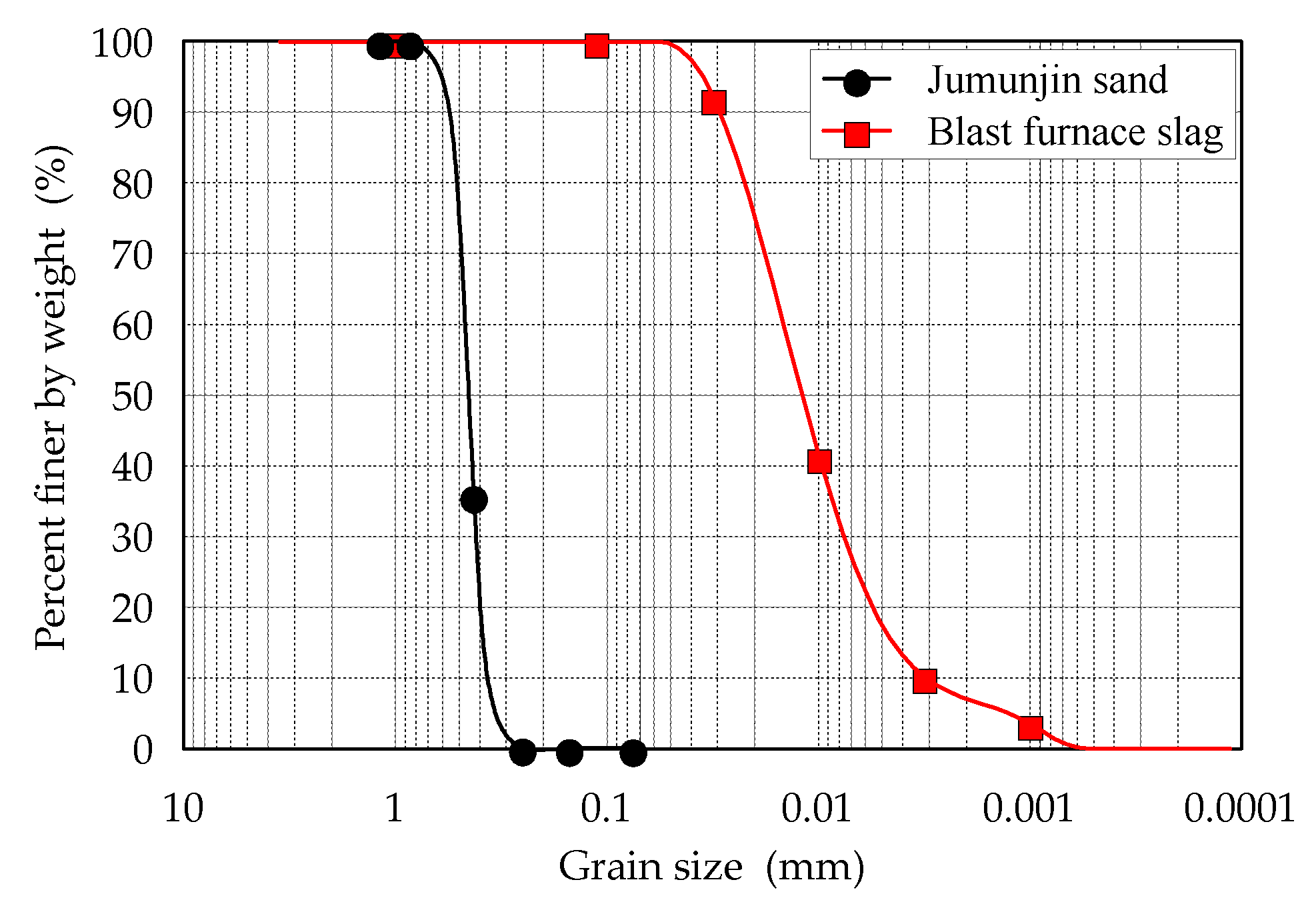
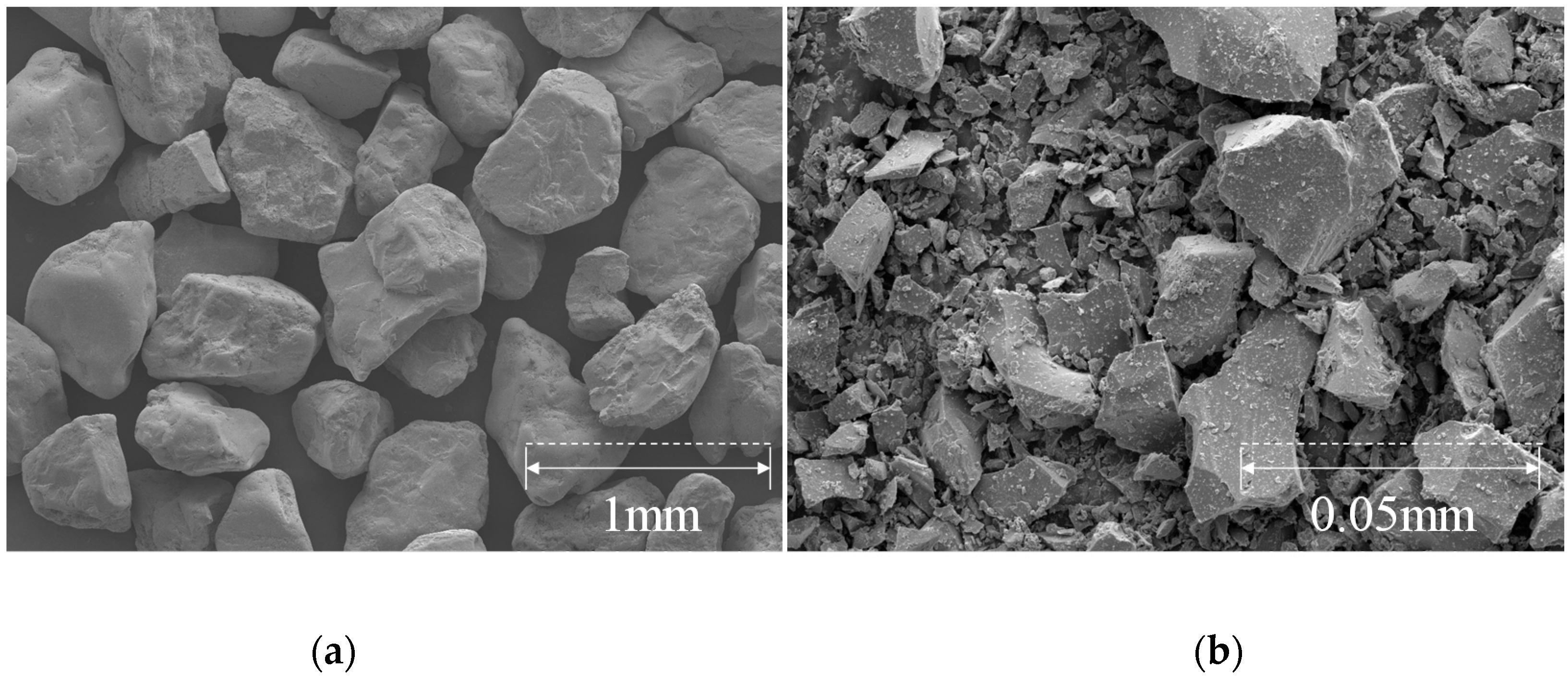

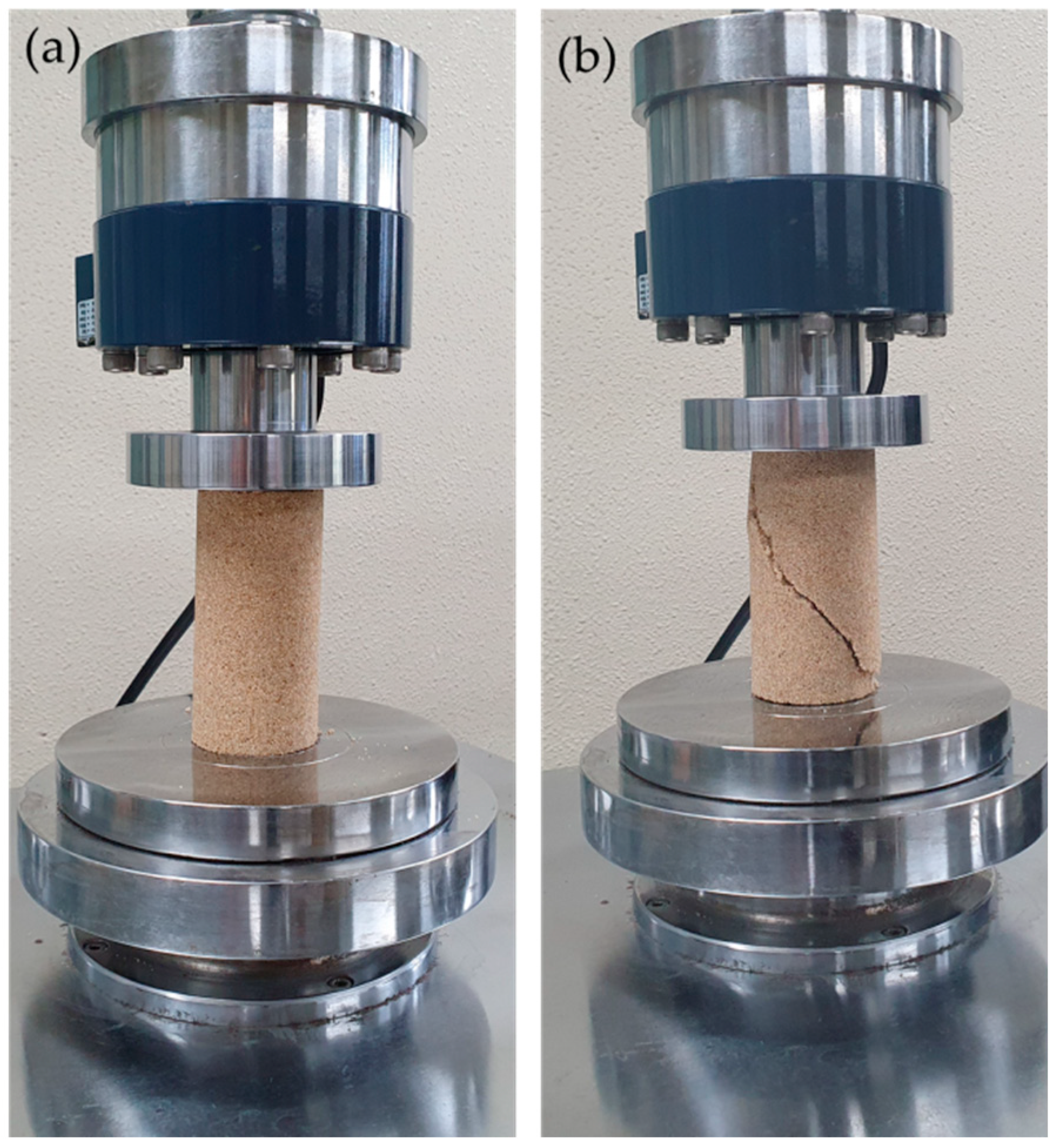
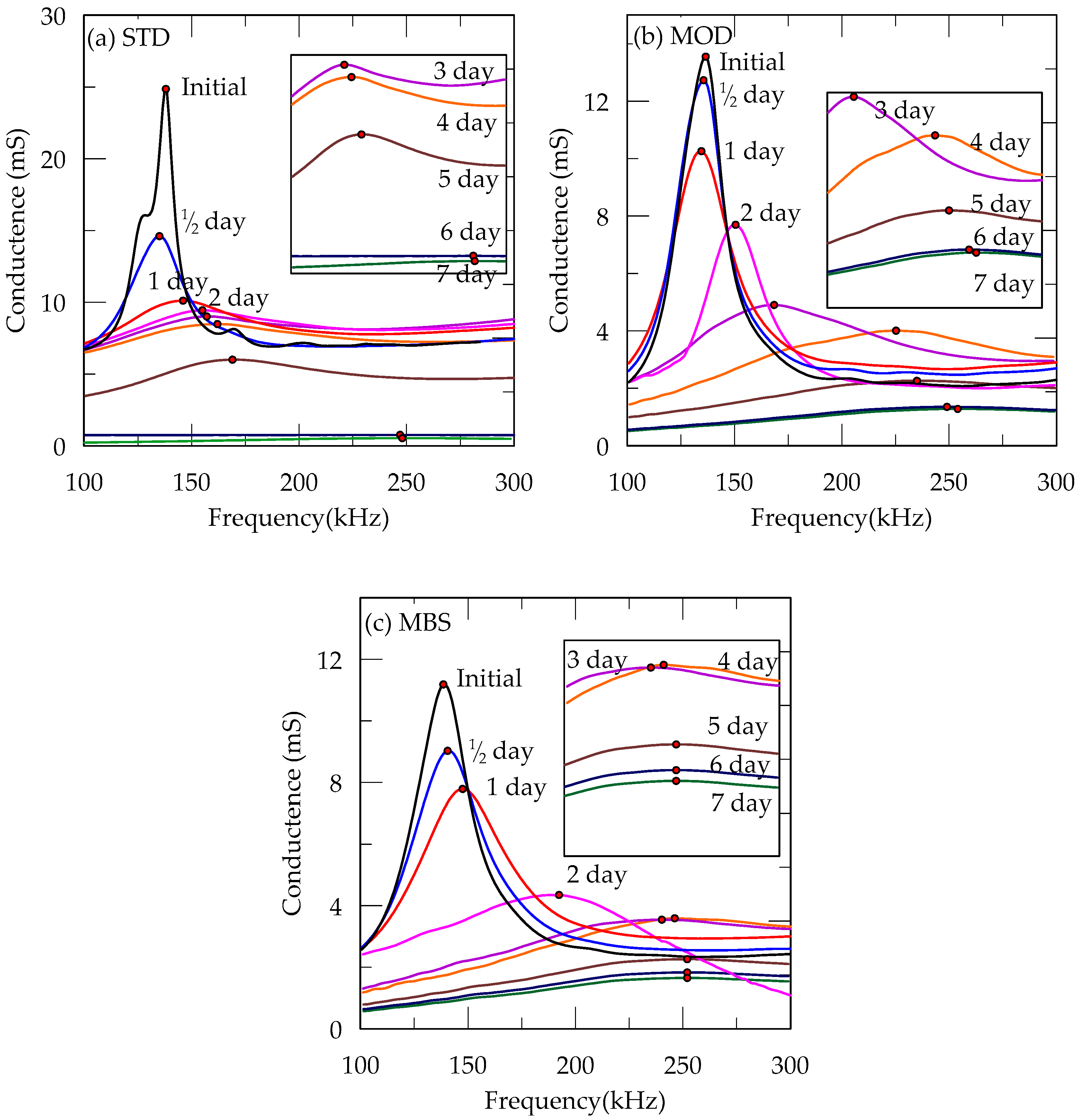

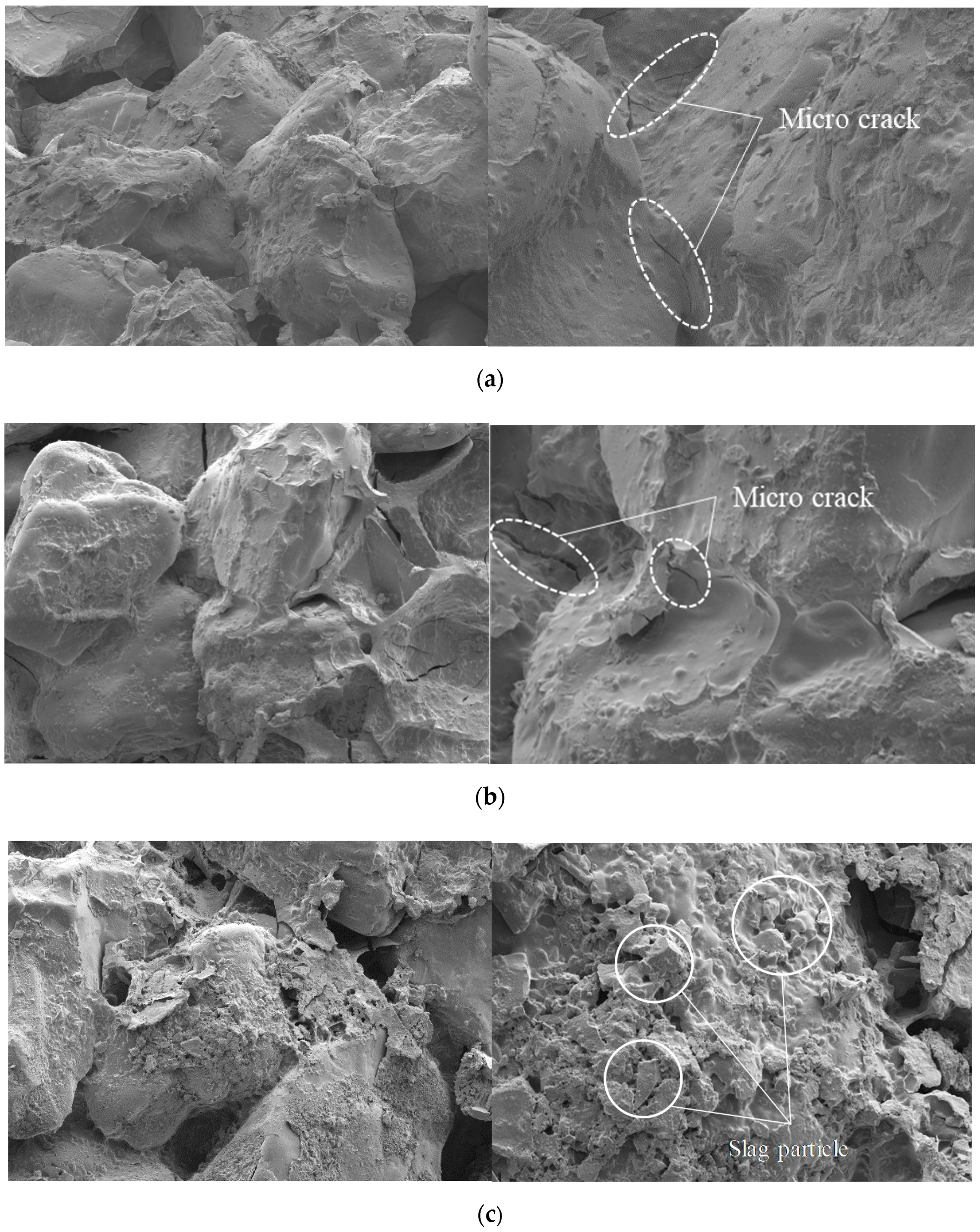
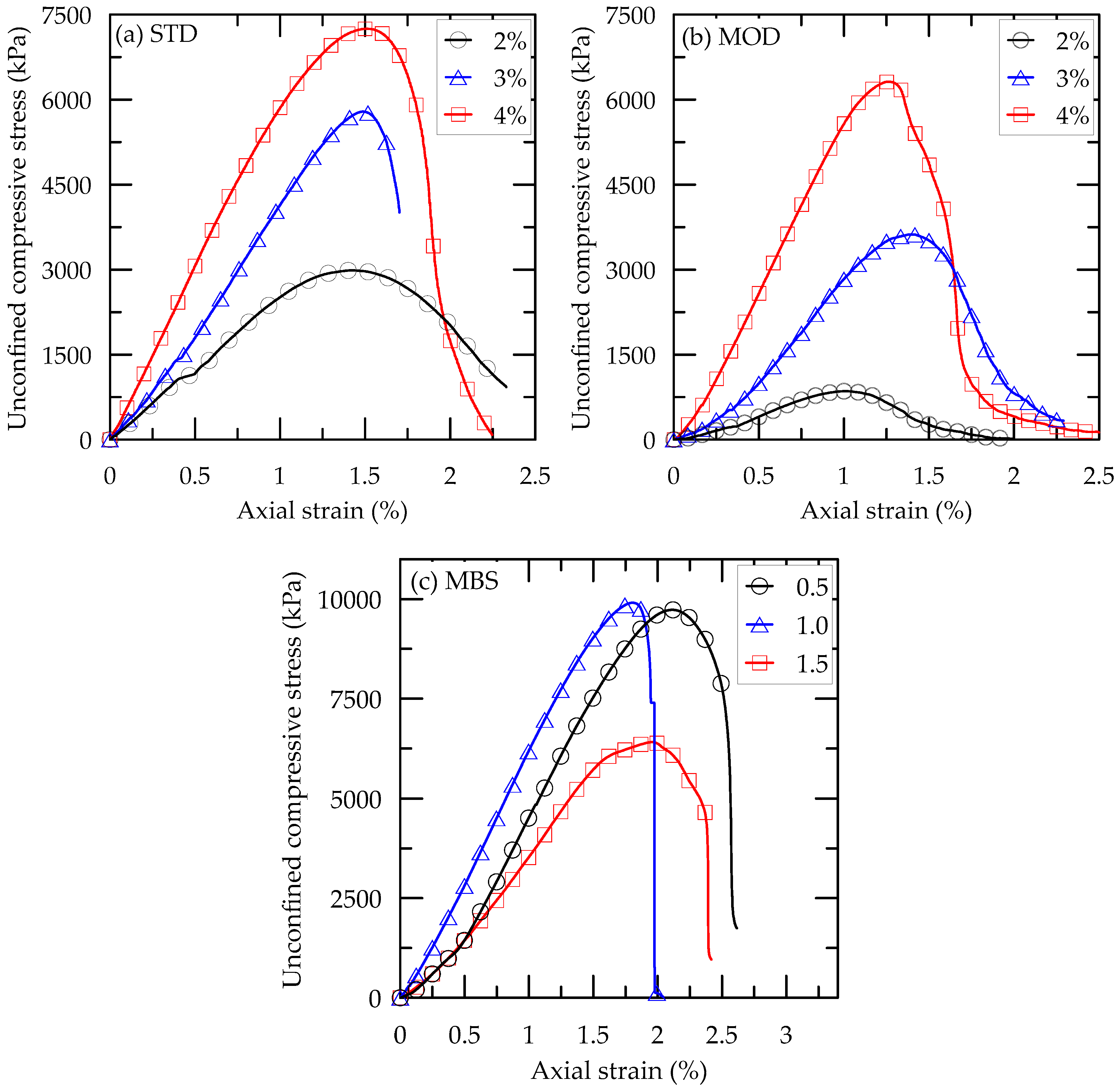
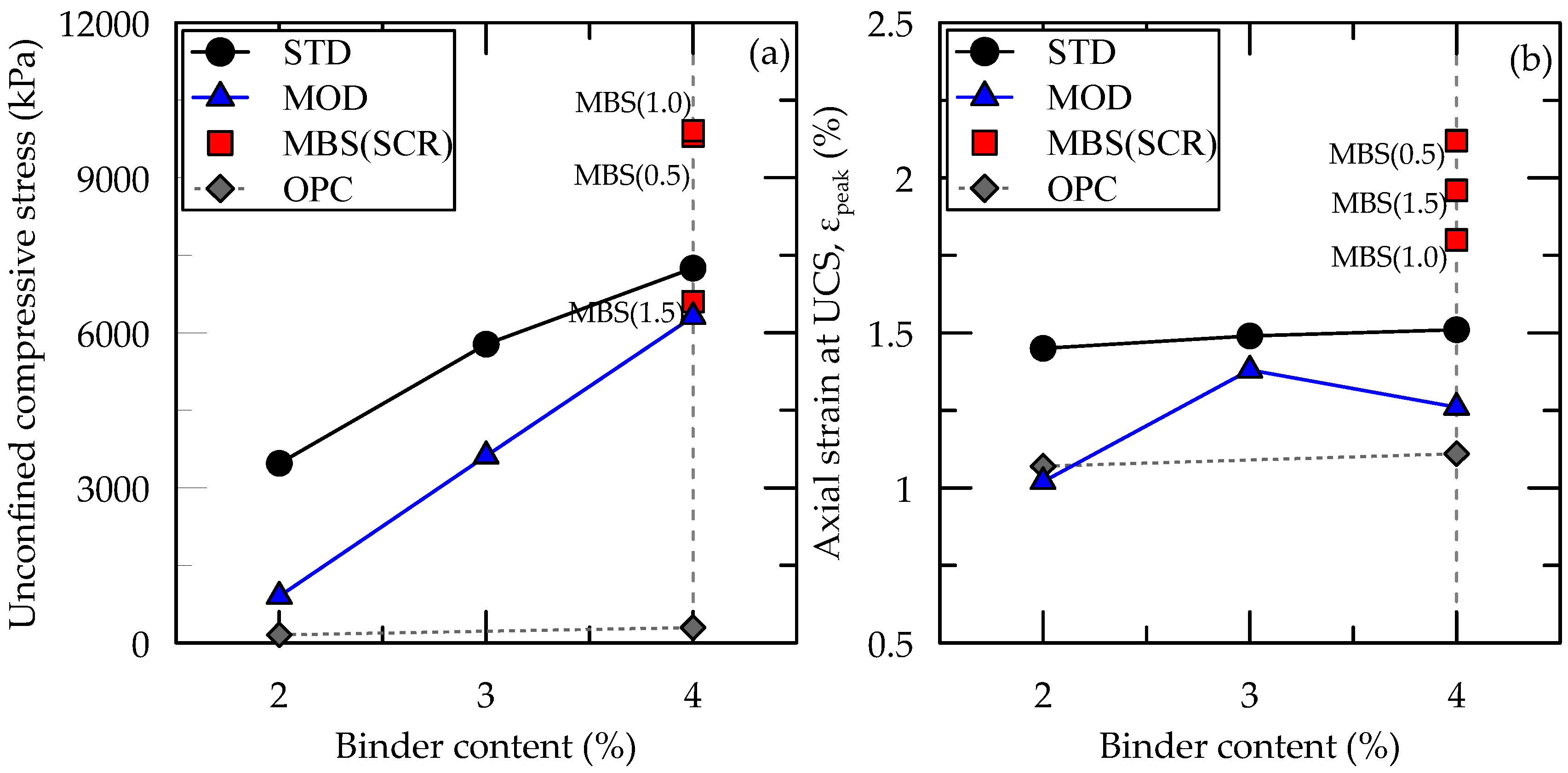
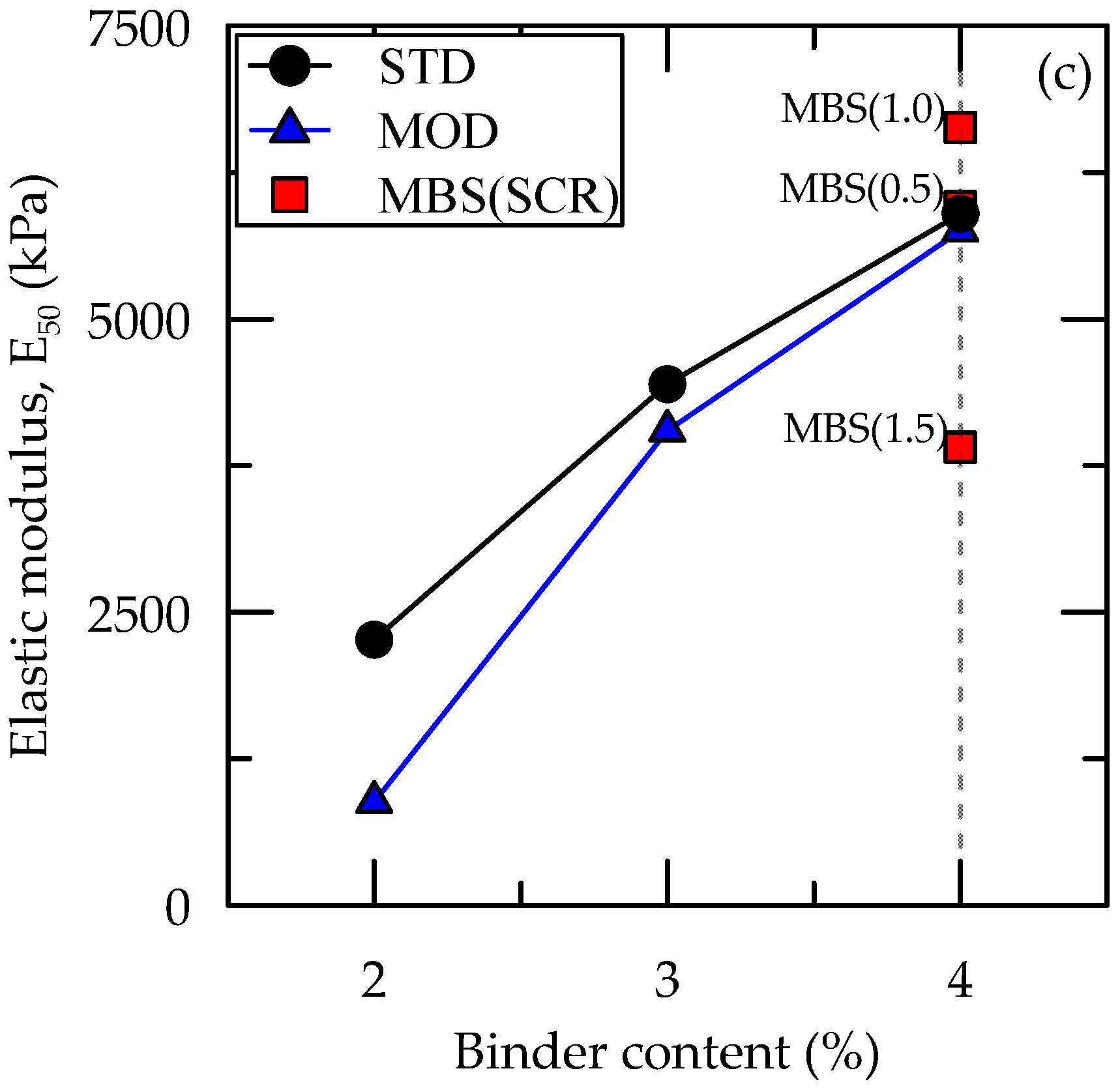

| Material | D60 (mm) | D30 (mm) | D10 (mm) | Coeff. of Uniformity, Cu | Coeff. of Gradation, Cc | Unified Soil Classification System |
|---|---|---|---|---|---|---|
| Jumunjin sand | 0.50 | 0.40 | 0.31 | 1.61 | 1.03 | Poorly graded sand (SP) |
| Blast furnace slag | 0.015 | 0.007 | 0.003 | 5 | 1.09 | - |
| SiO2 | Al2O3 | K2O | Na2O | Fe2O3 | CaO | BaO | Cl | L.O.I | |
|---|---|---|---|---|---|---|---|---|---|
| Component (%) | 87.70 | 6.61 | 4.03 | 0.76 | 0.25 | 0.11 | 0.09 | 0.07 | 0.38 |
| CaO | SiO2 | Al2O3 | MgO | SO3 | TiO2 | K2O | Fe2O3 | MnO | L.O.I | |
|---|---|---|---|---|---|---|---|---|---|---|
| Component (%) | 42.62 | 34.32 | 15.29 | 3.25 | 1.99 | 0.73 | 0.45 | 0.43 | 0.40 | 0.52 |
| Binder Ingredient | Standard Casein (g) | Modified Casein (g) | Modified Casein + BFS (g) |
|---|---|---|---|
| Casein | 100 | 100 | 100 |
| Distilled water | 250 | 250 | 250 |
| Calcium hydroxide | 20 | 26 | 26 |
| Sodium hydroxide | 11 | 5 | 5 |
| Blast furnace slag | - | - | 65.5, 131, 196.5 |
| ID | Binder Type | Binder Content (%) | Blast Furnace Slag/Casein (SCR) |
|---|---|---|---|
| STD | Standard | 2, 3, 4 | 0 |
| MOD | Modified | 2, 3, 4 | 0 |
| MBS | Modified + BFS | 4 | 0.5, 1.0, 1.5 |
| ID | Initial | ½ Day | 1 Day | 2 Day | 3 Day | 4 Day | 5 Day | 6 Day | 7 Day | |
|---|---|---|---|---|---|---|---|---|---|---|
| STD | P. C. * (mS) | 24.86 | 14.61 | 10.11 | 9.44 | 9.01 | 8.48 | 6.00 | 0.76 | 0.53 |
| C. F. ** (kHz) | 138 | 135 | 146 | 155 | 157 | 162 | 169 | 247 | 248 | |
| Water content (%) | - | - | - | - | 8.52 | 3.07 | 1.08 | 0.51 | 0.47 | |
| MOD | P. C. (mS) | 13.55 | 12.73 | 10.26 | 7.69 | 4.90 | 4.00 | 2.26 | 1.35 | 1.28 |
| C. F. (kHz) | 137 | 136 | 135 | 151 | 168 | 225 | 235 | 249 | 254 | |
| Water content (%) | - | - | - | - | 7.52 | 2.85 | 1.53 | 0.763 | 0.65 | |
| MBS | P. C. (mS) | 11.19 | 9.03 | 7.79 | 4.35 | 3.55 | 3.59 | 2.26 | 1.83 | 1.65 |
| C. F. (kHz) | 139 | 141 | 148 | 192 | 240 | 246 | 252 | 252 | 252 | |
| Water content (%) | - | - | - | - | 3.89 | 1.32 | 0.85 | 0.64 | 0.34 | |
| ID | Binder Type | Curing Condition | SCR | Binder Content (%) | Dry Unit Weight, γd (kN/m3) | Unconfined Compressive Strength (kPa) | Axial Strain at UCS, εpeak (%) | Elastic Modulus, E50 (kPa) |
|---|---|---|---|---|---|---|---|---|
| STD | Standard | 7 days in air | 0 | 2 | 15.51 | 3472 | 1.45 | 2265 |
| 3 | 15.84 | 5778 | 1.49 | 4444 | ||||
| 4 | 15.92 | 7249 | 1.51 | 5898 | ||||
| MOD | Modified | 7 days in air | 0 | 2 | 15.49 | 902 | 1.02 | 882 |
| 3 | 15.81 | 3616 | 1.38 | 4049 | ||||
| 4 | 15.89 | 6313 | 1.26 | 5752 | ||||
| MBS | Modified + BFS | 7 days in air | 0.5 | 4 | 16.05 | 9806 | 2.12 | 5959 |
| 1 | 16.17 | 9908 | 1.80 | 6635 | ||||
| 1.5 | 16.30 | 6600 | 1.96 | 3906 | ||||
| OPC | Ordinary Portland cement | 7 days in air | 0 | 2 | - | 155 | 1.07 | 117 |
| 4 | - | 296 | 1.11 | 322 | ||||
| 6 | - | 444 | 1.10 | 436 |
| ID | Binder Type | Binder Content (%) | SCR | Jar Slake Category at Soaking Time | |||||||
|---|---|---|---|---|---|---|---|---|---|---|---|
| 3 h | 6 h | 9 h | 12 h | 15 h | 18 h | 21 h | 24 h | ||||
| STD | Standard | 4 | - | C1 | C1 | C1 | C1 | C1 | C1 | C1 | C1 |
| MOD | Modified | 4 | - | C6 | C6 | C4 | C3 | C3 | C3 | C1 | C1 |
| MBS | Modified + BFS | 4 | 1.0 | C6 | C6 | C6 | C6 | C6 | C6 | C6 | C6 |
| Binder Type | Case | 1 Day | 2 Day | 3 Day | 4 Day | 5 Day | 6 Day | 7 Day |
|---|---|---|---|---|---|---|---|---|
| Modified + BFS | Wet-1 | Mold | Water | UCS test | ||||
| Wet-2 | Mold | Water | Air | Water | UCS test | |||
| Wet-3 | Mold | Water | Air | Water | Air | Water | UCS test |
| ID | Binder Type | SCR | Binder Content (%) | Case | Unconfined Compressive Strength (kPa) | Axial Strain at UCS, εpeak (%) | Elastic Modulus, E50 (kPa) |
|---|---|---|---|---|---|---|---|
| MBS | Modified + BFS | 1.0 | 4 | Wet-1 | 436 | 2.99 | 229 |
| Wet-2 | 120 | 4.06 | 39 | ||||
| Wet-3 | 68 | 3.51 | 24 |
© 2020 by the authors. Licensee MDPI, Basel, Switzerland. This article is an open access article distributed under the terms and conditions of the Creative Commons Attribution (CC BY) license (http://creativecommons.org/licenses/by/4.0/).
Share and Cite
Park, S.-S.; Woo, S.-W.; Jeong, S.-W.; Lee, D.-E. Durability and Strength Characteristics of Casein-Cemented Sand with Slag. Materials 2020, 13, 3182. https://doi.org/10.3390/ma13143182
Park S-S, Woo S-W, Jeong S-W, Lee D-E. Durability and Strength Characteristics of Casein-Cemented Sand with Slag. Materials. 2020; 13(14):3182. https://doi.org/10.3390/ma13143182
Chicago/Turabian StylePark, Sung-Sik, Seung-Wook Woo, Sueng-Won Jeong, and Dong-Eun Lee. 2020. "Durability and Strength Characteristics of Casein-Cemented Sand with Slag" Materials 13, no. 14: 3182. https://doi.org/10.3390/ma13143182
APA StylePark, S.-S., Woo, S.-W., Jeong, S.-W., & Lee, D.-E. (2020). Durability and Strength Characteristics of Casein-Cemented Sand with Slag. Materials, 13(14), 3182. https://doi.org/10.3390/ma13143182






